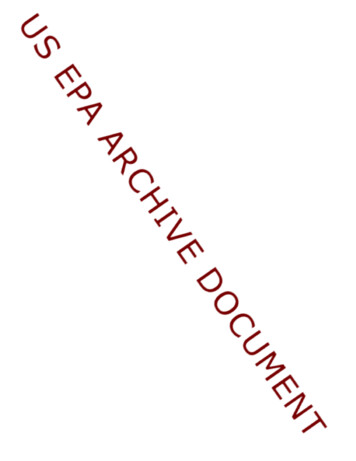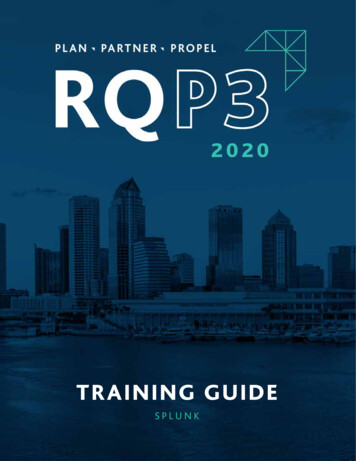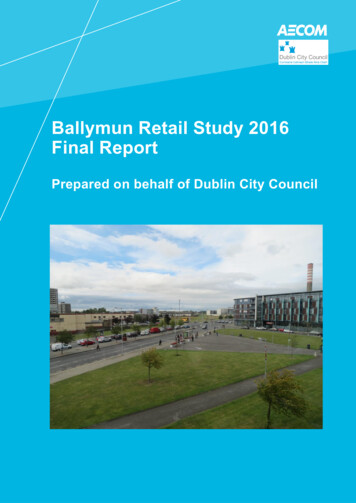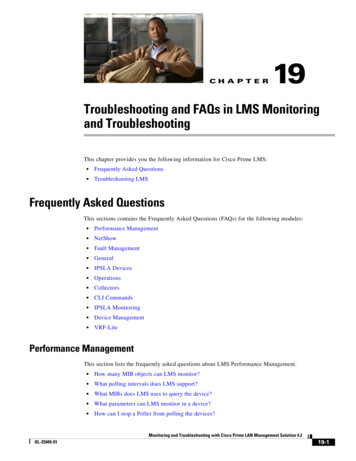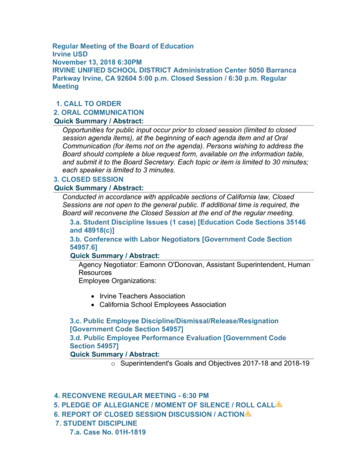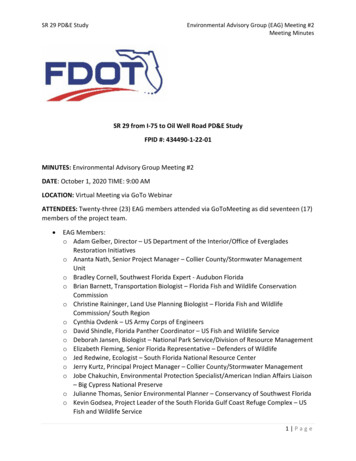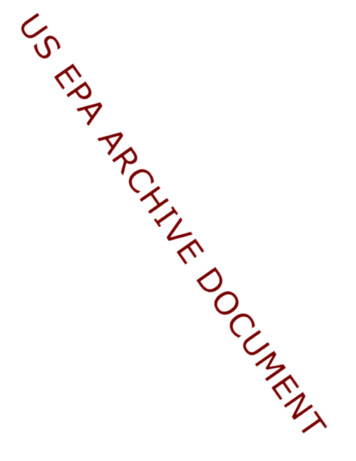
Transcription
cc:Stephen OwensLouise WiseVicki DellarcoWilliam JordanMargie FehrenbachKeith MatthewsDonald BradyJack HousengerJoan Harrigan-FarrellyLois RossiJay EllenbergerKaren WhitbyJack FowleRichard KeigwinAnna LowitElizabeth MendezCarol ChristensenChester RodriguezRalph CooperMary FrankenberryNelson ThurmanDale KemeryEnesta JonesDouglas ParsonsVanessa VuOPP DocketFIFRA Scientific Advisory Panel MembersDaniel Griffith, Ph.D.William Hayton, Ph.D.Nelson Horseman, Ph.D.Travis Jerde, Ph.D.Herbert Lee, Ph.D.James McManaman, Ph.D.Bette Meek, Ph.D.Kevin O'Byrne, Ph.D.Katherine Roby, Ph.D.Barry Timms, Ph.D.Heather Young, Ph.D., M.P.H.Janice Chambers, Ph.D., DABT, Fellow ATSStephen Klaine, Ph.D.Daniel Schlenk, Ph.D.Kenneth Portier, Ph.D.Susan Akana, Ph.D.Frank Bove, Sc.D.Richard Coupe, Ph.dPenelope Fenner-Crisp, Ph.D., DABTRobert Gilliom, M.S.Ellen Gold, Ph.D.Richard Greenwood, Ph.D2
SAP Minutes No. 2011-05A Set of Scientific Issues Being Considered by theEnvironmental Protection Agency Regarding:Re-evaluation of the Human Health Effectsof Atrazine: Review of Non-Cancer Effects, DrinkingWater Monitoring Frequency and CancerEpidemiologyJuly 26 – 28, 2011FIFRA Scientific Advisory Panel MeetingHeld at theEnvironmental Protection Agency Conference CenterArlington, VA
NOTICEThese meeting minutes have been written as part of the activities of the FederalInsecticide, Fungicide and Rodenticide Act (FIFRA), Scientific Advisory Panel (SAP). Themeeting minutes represent the views and recommendations of the FIFRA SAP, not the UnitedStates Environmental Protection Agency (Agency). The content of the meeting minutes does notrepresent information approved or disseminated by the Agency. The meeting minutes have notbeen reviewed for approval by the Agency and, hence, the contents of these meeting minutes donot necessarily represent the views and policies of the Agency, nor of other agencies in theExecutive Branch of the Federal Government, nor does mention of trade names or commercialproducts constitute a recommendation for use.The FIFRA SAP is a Federal advisory committee operating in accordance with theFederal Advisory Committee Act and established under the provisions of FIFRA as amended bythe Food Quality Protection Act (FQPA) of 1996. The FIFRA SAP provides advice,information, and recommendations to the Agency Administrator on pesticides and pesticiderelated issues regarding the impact of regulatory actions on health and the environment. ThePanel serves as the primary scientific peer review mechanism of the Environmental ProtectionAgency, Office of Pesticide Programs (OPP), and is structured to provide balanced expertassessment of pesticide and pesticide-related matters facing the Agency. FQPA Science ReviewBoard members serve the FIFRA SAP on an ad hoc basis to assist in reviews conducted by theFIFRA SAP. Further information about FIFRA SAP reports and activities can be obtained fromits website at http://www.epa.gov/scipoly/sap/ or the OPP Docket at (703) 305-5805. Interestedpersons are invited to contact Joseph E. Bailey, SAP Designated Federal Official, via e-mail atbailey.joseph@epa.gov.In preparing these meeting minutes, the Panel carefully considered all informationprovided and presented by EPA, as well as information presented by public commenters.
TABLE OF CONTENTSPARTICIPANTS.2INTRODUCTION.4PUBLIC COMMENTS .6SUMMARY OF PANEL DISCUSSION AND RECOMMENDATIONS .7DETAILED PANEL DELIBERATIONS AND RESPONSE TO CHARGE.22Panel Response to Charge Question 1a.22Panel Response to Charge Question 1b .24Panel Response to Charge Question 2a.25Panel Response to Charge Question 2b .31Panel Response to Charge Question 3.33Panel Response to Charge Question 4a.36Panel Response to Charge Question 4b .38Panel Response to Charge Question 4c .38Panel Response to Charge Question 5.39Panel Response to Charge Question 6.41Panel Response to Charge Question 7.44Panel Response to Charge Question 8.48Panel Response to Charge Question 9.51Panel Response to Charge Question 10.55Panel Response to Charge Question 11a.65Panel Response to Charge Question 11b .70Panel Response to Charge Question 12a.72Panel Response to Charge Question 12b .73Panel Response to Charge Question 12c .77Panel Response to Charge Question 12d .81Panel Response to Charge Question 13a.82Panel Response to Charge Question 13b .83Panel Response to Charge Question 13c .84Panel Response to Charge Question 14a.85REFERENCES .96APPENDIX 1 .103
Federal Insecticide Fungicide and Rodenticide ActScientific Advisory Panel MeetingJuly 26 - 28, 2011PARTICIPANTSFIFRA SAP ChairKenneth Portier, Ph.D., Program Director, Statistics, American Cancer Society, National HomeOffice, Atlanta, GAFIFRA SAP Session ChairDaniel Schlenk, Ph.D., Professor of Aquatic Ecotoxicology and Environmental Toxicology,Department of Environmental Sciences, University of California, Riverside, CADesignated Federal OfficialJoseph E. Bailey, FIFRA Scientific Advisory Panel, Office of Science Coordination and Policy,EPAFIFRA Scientific Advisory Panel MembersJanice Chambers, Ph.D., DABT, Fellow ATS, Director, Center for Environmental HealthSciences, College of Veterinary Medicine, Mississippi State University, Mississippi State, MSStephen Klaine, Ph.D., Professor, Department of Biological Sciences, Director, Institute ofEnvironmental Toxicology, Clemson University, Pendleton, SCFIFRA Science Advisory Board MembersSusan F. Akana, Ph.D., Instructor, Department of Biological Sciences, City College of SanFrancisco, San Francisco, CAFrank J. Bove, Sc.D., Senior Epidemiologist, Division of Health Studies, Agency for ToxicSubstances & Disease Registry (ATSDR)/CDC, Atlanta, GARichard H. Coupe, Ph.D., Supervisory Hydrologist/Associate Water Science Director, U.S.Geological Survey, Pearl, MSPenelope A. Fenner-Crisp, Ph.D., DABT, Consultant, North Garden, VARobert J. Gilliom, M.S., Chief, Pesticide National Synthesis, National Water QualityAssessment Program, U.S. Geological Survey, Sacramento, CA2
Ellen B. Gold, Ph.D., Professor and Chair, Department of Public Health Sciences, School ofMedicine, University of California - Davis, Davis, CARichard Greenwood, Ph.D., Professor Emeritus, School of Biological Sciences, University ofPortsmouth, Portsmouth, United KingdomDaniel A. Griffith, Ph.D., Ashbel Smith Professor, School of Economic, Political and PolicySciences, University of Texas at Dallas, Richardson, TXWilliam Hayton, Ph.D., Professor Emeritus, Division of Pharmaceutics, The Ohio StateUniversity, Columbus, OHNelson D. Horseman, Ph.D., Professor, Department of Molecular and Cellular Physiology,Program in Systems Biology and Physiology, University of Cincinnati, Cincinnati, OHTravis Jerde, Ph.D., Assistant Professor, Indiana University School of Medicine, Department ofPharmacology and Toxicology, Indianapolis, INHerbert K. H. Lee, Ph.D., Professor, Department of Applied Mathematics and Statistics, ViceProvost for Academic Affairs, University of California - Santa Cruz, Santa Cruz, CAJames L. McManaman, Ph.D., Professor, Department of Obstetrics and Gynecology, DivisionChief, Basic Reproductive Sciences, University of Colorado – Denver, Aurora, COM.E. (Bette) Meek, Ph.D., Associate Director, Chemical Risk Assessment, McLaughlinInstitute for Population Health Risk Assessment, University of Ottawa, Ottawa, Ontario, CanadaKevin T. O'Byrne, Ph.D., Professor, Department of Anatomy and Human Sciences, Division ofReproduction and Endocrinology, School of Biomedical and Health Sciences, King’s CollegeLondon, Guy’s Campus, London, United KingdomKatherine Roby, Ph.D., Director, Reproductive Endocrinology Laboratory, Center forAdvanced Reproductive Medicine, University of Kansas Medical Center, Kansas City, KSBarry G. Timms, Ph.D., Professor, Division of Basic Biomedical Sciences, University of SouthDakota, Vermillion, SDHeather A. Young, Ph.D., M.P.H., Associate Professor and Associate Chair, Department ofEpidemiology and Biostatistics, The George Washington University School of Public Health &Health Sciences, Washington, DC3
INTRODUCTIONThe Federal Insecticide, Fungicide and Rodenticide Act Scientific Advisory Panel(FIFRA SAP) has completed its review of the Reevaluation of the Human Health Effects ofAtrazine: Review of Non-cancer Effects, Drinking Water Monitoring Frequency and CancerEpidemiology. Advance notice of the meeting was published in the Federal Register onMay 6, 2011. The review was conducted in an open panel meeting held in Arlington, VA, onJuly 26 - 28, 2011. Dr. Daniel Schlenk chaired the meeting. Joseph E. Bailey served as theDesignated Federal Official.EPA is undertaking a re-evaluation of the human health effects of atrazine. The humanhealth re-evaluation has involved three SAP meetings in 2010 and one in 2011. The firstmeeting was held in February 2010 during which the Agency presented its preliminary reviewsof several atrazine epidemiology studies on birth outcomes and described a project plan toevaluate atrazine epidemiology data from the Agricultural Health Study. The second meetingheld in April 2010 focused on 1) a preliminary review of experimental toxicology studies fromlaboratory mammals and in vitro studies and recent advances in understanding atrazine’s modeof action along with 2) statistical and modeling approaches for evaluating monitoring frequencyin community water systems (CWS). The September 2010 meeting built on the scientificanalysis and SAP feedback from the April meeting. Specifically, the Agency presented scientificanalyses on an empirical approach for estimating internal dosimetry and calculation ofbenchmark dose estimates for purposes of deriving points of departure. In addition, EPApresented a general strategy for designing a monitoring study to characterize drinking waterexposures and discussed different methods for analyzing and interpreting monitoring datacollected at different sampling frequencies. The September 2010 meeting also providedproposals for updating the critical duration(s) of exposure based on the new science and apreliminary evaluation of potential susceptibility of the young. In addition, the September 2010meeting included evaluation of non-cancer epidemiology studies, a weight of the evidenceevaluation of the non-cancer epidemiology studies with experimental laboratory studies and aproposal to use the non-cancer epidemiology studies qualitatively in evaluating the humanrelevance of experimental toxicology findings.The July 2011 SAP meeting built on the scientific analyses and SAP feedback from theprevious three SAPs by proposing a conceptual framework for the evaluation of atrazine humanhealth non-cancer effects. This proposed conceptual framework integrated information on modeof action and adverse outcome pathways, potentially susceptible lifestages/subpopulations,drinking water exposure, internal dosimetry and water monitoring sampling uncertainty. TheAgency solicited comment on the overall integrative approach proposed for atrazine along withtechnical considerations for each scientific component. To illustrate the conceptual framework, acase study was presented that demonstrated an approach for estimating non-cancer risk toatrazine based on an internal dose metric for temporally, spatially and demographically explicitinformation. The Agency also provided a preliminary review of cancer epidemiology studies,including the Agricultural Health Study, and a draft weight of the evidence (WOE) analysis oncancer that integrated mode of action, experimental toxicology information and epidemiology.4
The draft WOE analysis followed the Draft Framework for Incorporating Epidemiologic andHuman Incident Data in Health Risk Assessment, which was reviewed by the SAP in February,2010. And finally, the Agency presented information regarding the continued development ofthe statistical analysis of drinking water monitoring data.Opening remarks at the meeting were provided by Steven Bradbury, Ph.D., Director,Office of Pesticide Programs and John (Jack) R. Fowle III, Ph.D., Associate Director, HealthEffects Division, Office of Pesticide Programs. Agency presentations were given by ElizabethMendez, Ph.D., Carol Christensen, Ph.D. and Chester Rodriguez, Ph.D., Health Effects Division;Nelson Thurman, M.S., Environmental Fate and Effects Division, all of the Office of PesticidePrograms; and Ralph C. Cooper, Ph.D., National Health and Environmental Effects ResearchLaboratory, Office of Research and Development.5
PUBLIC COMMENTSOral Statements were presented as follows:Janis McFarland, Ph.D., Charles Breckenridge, Ph.D., Paul Hendley, Ph.D., James Simpkins,Ph.D. (University of North Texas), Tony M. Plant, Ph.D. (University of Pittsburgh), and HarveyClewell, Ph.D. (The Hamner Institutes for Health Sciences) all on behalf of Syngenta CropProtectionWendelyn Jones, Ph.D., on behalf of CropLife AmericaScott Slaughter on behalf of the Center for Regulatory EffectivenessJere White and James C. Lamb, Ph.D., on behalf of the Triazine NetworkSarah Gallo on behalf of the National Corn Growers AssociationTyler Wegmeyer on behalf of the American Farm Bureau FederationStephanie Whalen on behalf of the Hawaii Agricultural Research CenterWritten Statements were provided by:Jean PublicDanielle DestefanoLydia LambertDan Campbell on behalf of Syngenta Crop ProtectionRobert M. Gould, MD, on behalf of Physicians for Social Responsibility6
SUMMARY OF PANEL DISCUSSION AND RECOMMENDATIONSCharge Issue 1a - Reasonable representation of bias factor for watershed sizeand water body typeThe Panel noted that there is no simple answer to the question posed because there areinsufficient data for an adequate range of sites and years to reliably address the problem.Furthermore, as shown by available calculations of site-year bias factors, each individual site hasunique characteristics that govern the adequacy of different sampling frequencies. Accordingly,the Panel offered for consideration three approaches to address the problem. The first approachis to conduct an evaluation of “homogeneous” groups to develop a categorical system of biasfactors. If there are usable, discrete groups, as opposed to a continuum, then perhaps 30 sites ineach group, with 10 years of high-quality data each would be a reasonable start. Reservoirs,however, which account for a large proportion of the Community Water Systems (CWS), willprobably be difficult, if not impossible, to categorize because of highly variable characteristics,such as volume and residence time, which are not readily obtainable. The second approach isregression of bias vs. explanatory variables, such as basin characteristics and water-body type,thus expressing bias as a continuum governed by specific basin characteristics. This approachcould be promising for at least certain parts of the problem, such as watershed size for flowingstreams, but more data for multiple years will be needed at selected sites, as well as at additionalsites with intermediate basin sizes. The third approach would use characteristics of a “worst casegroup,” such as small basins, to yield a conservatively high bias factor for protective screeningthat would trigger monitoring. This is a practical approach that can be used now, because thereis relative confidence that flowing water sites with small basins, such as the Atrazine EcologicalEffects Monitoring Program (AEEMP) sites and other small-basin sites, define the worst casebias factors, both for larger flowing streams and for reservoirs, at least regarding the shortduration concentrations on which the Agency is focusing. There are a significant number ofCWS within the watershed size range of the AEEMP sites and, thus, the AEEMP sites are usefuland applicable for defining characteristics of small-basin CWS sites in vulnerable settings. Aremaining overall weakness for applying these approaches is the lack of sufficient multi-yeardata. Thus, it is important to continue systematic monitoring at selected sites.Charge Issue 1b - Bias factors based on individual sites and years versuspercentiles of averages across sites/yearsThe fundamental unit of exposure assessment, given the exposure conditions emphasizedby the Agency for atrazine, is each individual site-year combination. Because each CWS site isunique, analysis generally needs to focus on each individual CWS as a unit. It is important tocompute bias factors for an individual site for a particular year, and then each of these biasfactors can be compared across years and across sites. Alternatively, combining data across sitesand/or years before computing the bias factor will smooth out variability, downwardly biasingestimates of exposure at the peak. The condition of concern is when the maximum of a selectedrolling average duration exceeds a level of concern, and this tends to be most likely in high useseasons during years when runoff after applications is high. Bias factors, to the extent they are7
used for screening-level analysis, should be developed with the objective of identifying sites thatmerit direct monitoring. They may also be useful as a simple and transparent approach toestimating exposure for sparsely monitored sites for other purposes, such as for large-scale riskassessments or correlation with epidemiologic results. In these applications, the starting pointfor analysis and the endpoint of interest is the individual site, not groups of sites. However, theremay be certain data analysis approaches that use data from groups of sites to make inferences forindividual sites. This can be done as long as the uncertainties in predictions for individual sitesare properly represented.Charge Issue 2a - Agency's method of estimating time series using conditionalsimulations of variograms for monitoring data sets having 7-day samplingfrequencyThe Agency's method acknowledges the serial correlation latent in time series data.Conventional Box-Jenkins type ARIMA (autoregressive integrative moving average) modelsrequire uniform spacing in time, but more effectively address seasonality. Restricting attentionto the days of interest appears to handle the stationarity issue in an effective way. However,sample atrazine data in Table D1.1 in Appendix D of the EPA Issue Paper imply that Julian days101-200 may be the wrong time interval; the start time seems to be closer to Julian day 130, andseems to go beyond Julian day 200; the most recent Syngenta data support this contention forsome of the other watersheds. The complication here may well be that different CWS will havedifferent Julian day time periods (i.e., geographic variation in the windows across CWS). Anymethodology that focuses on mean responses (e.g., moving averages) tends to underestimatepeak atrazine concentration. Virtually all software packages report standard errors for the caseof random sampling. The assumption that they are the same for systematic or stratified randomsampling or for the observed non-probability sample of monitored days may well seriouslyimpact upon the uncertainty assessment. In addition, the assumption that unsampled days aremissing at random seems questionable. In contrast, the assumption that missing years for anyCWS are by design, and hence eliminating those years from the population of interest, seemsreasonable. Perhaps assessments within the context of mixed modeling could furnish insightshere. The Panel noted other significant concerns related to possible impacts of the followingissues: 1) misspecification of the semi-variogram model (a wide range of forms should beexamined); 2) assuming that atrazine concentration data conform to a log-normal rather thananother extreme value distribution (which can be dramatic in terms of the estimation of 95thpercentiles); 3) ignoring spatial autocorrelation (which are less on mean patterns, and muchmore on 95th percentile estimates through effects on variance); 4) assuming a linear relationshipbetween atrazine concentrations and "covariates" (again, potentially more dramatic on 95thpercentile estimates, and adding to uncertainty rather than improving estimability); and 5) notperforming a sufficient number of simulations to adequately establish the uncertaintydistributions (again, especially on 95th percentile estimates rather than on mean patterns).8
Charge Issue 2b - WARP (Watershed Regressions for Pesticides) modelingwith longer duration sampling intervalsWhen monitoring data are inadequate for using kriging, time series models, or other datafill-in methods, or for reasonable sample estimates to be combined with a bias factor, WARPfurnishes imputations for estimating specified concentration statistics based only on readilyavailable watershed characteristics. WARP can be used to estimate distributional parameters,which then can be used with SEAWAVE (a parametric regression model with seasonal wave) toconstruct a time series that conforms, or it can be used to estimate the concentration statistic ofinterest (such as the predicted annual maximum 14-day rolling average) for a particular site.However, WARP is an empirical model that is subject to the same biases as the data used tobuild it. As such, depending on the desired application, a problem-specific version of WARPshould be fit to data that are relevant to specified objectives. This perspective is consistent withprevious SAP recommendations. Recognizing that EPA seeks reasonable estimates of exposureto atrazine from limited data, fine tuning of the Agency’s current approach may yield a numberof benefits, whereas diminishing returns in additional accuracy of atrazine estimates almostcertainly will result as the complexity of the methodology increases. Furthermore, asmethodological complexity increases, chances of user error also increase; the final methodologyneeds to be implementable by various EPA scientists with a diverse set of expertise. In otherwords, EPA must establish acceptable trade-offs between theory and practice in its assessment.Charge Issue 3a - Modeling approaches for interpreting less frequentlysampled monitoring datasetsWhen the data are sparse, it will not be possible to fit a variogram or to get accurateresults solely from kriging or linear interpolation. One approach explored by EPA uses flow as acovariate. However, the initial results are not promising. There appear to be more complexrelationships than a simple linear relation with flow. Precipitation might be more useful thanflow as a predictor. WARP was developed to better model this situation, and it seems like itwould be better to use WARP than to try to re-invent it. PRZM (Pesticide Root Zone Model)predicts chemical movement in surface soil, yielding a daily time series of potential runoff eventbased concentrations, and requires more input than the WARP model. EXAMS (ExposureAnalysis Modeling System) predicts the fate, transport and exposure concentration in surfacewater and also requires more input than the WARP model. Finally, the mass-balance modelproduces atrazine discharge mass quantities that often differ by orders of magnitude in either apositive or a negative direction. Consequently, WARP combined with a time-series model suchas SEAWAVE, to produce a time series from the predicted statistics, appears to be a reasonablechoice for obtaining supplemental data.Output from the model yielding the best estimate of daily atrazine concentrations shouldbe employed as the covariate in kriging. If the output for any single model appears to be nobetter than that for any other model, perhaps a weighted average of daily model output could beutilized. Theoretically, if no relationship exists between the model-generated data and theobserved monitoring data, then the deterministic values do not impact upon the kriged values.As the relationship between the deterministic model output and the monitoring data increases in9
strength, increasingly more information can be borrowed from the deterministic model output tocomplete each daily time series. This procedure is far superior to linear interpolation.Syngenta's approach using PRZM appears promising and the Panel encouraged that it beexplored further. One could take a conservative approach using PRZM to help fill in large gapsand then account for the bias from infrequent sampling. PRZM was not initially intended for thissort of use, but it seems to perform reasonably well. SEAWAVE is an alternative model whichis closer in design intention to the atrazine monitoring problem than is PRZM, and also couldprove helpful. Another alternative is to consider approaches that learn from the models withoutneeding to run the models for future years. For example, one could try regression of the sampledconcentration time series on the PRZM time series, using an assumed polynomial or non-linearmodel or using some robust smoothing approach such as LOESS (locally weighted polynomialregression), properly lagged.Charge Issue 4a - Use of existing atrazine monitoring data to characterizerange in year-to-year variability in atrazine/TCT concentrationsWhether there are sufficient data or not depends somewhat upon the objective. If theobjective is to estimate a conservatively protective bias factor to apply to sparse monitoring data,then the collection of available data, including the Atrazine Monitoring Plan (AMP) data, couldbe used to derive reasonable criteria that would trigger detailed monitoring of a CWS. However,if the objective is to replace detailed monitoring with predictions, the range of variabilitybetween sites and years indicates that more data would be needed to develop useful quantitativerelationships, and that this would need to include detailed watershed data on a year-by-yearbasis. Additionally, the major drivers of atrazine concentrations in surface water have thepotential to change over time and from year to year; therefore, monitoring is necessary for theforeseeable future; however, it is probably not necessary to monitor everywhere at all times. Ithas been demonstrated many times in chemographs presented by EPA and Syngenta how easy itwould be to underestimate or completely miss a high concentration based on a small sample set.Using a model such as WARP which uses basin dependent variables and rainfall isrecommended as a screening tool for inclusion in the program. One of the weaknesses in someof the historical datasets is that total chlorotriazines were not measured. Another importantfactor is various sources of error, whether or not they are multiplicative and how that mightaffect interpretation of data. There is a tremendous amount of data available, and further workshould be done to characterize the site-to-site and year-to-year variability and the factors thatinfluence the differences. Another important point is that the collection of some dailymonitoring data needs to continue into the future so that current datasets are available that reflectchanges in the factors that control runoff.Charge Issue 4b - Use of PRIZM hybrid modelEPA should continue to pursue this approach because of the broad range of potentialbenefits of having a validated PRZM model for pesticide analysis. However, it should probablybe viewed as a longer term potential tool and should not get in the way of moving ahead with thesimpler transparent tools already available. An added benefit of continued development ofPRZM is that the same development of watershed data, such as weather data and soils, can also10
be used for site-by-site time series modeling. The hybrid model shows promise; however,PRZM is an edge-of-field model and not meant for larger basins and it does not model hydrologyexplicitly.Charge Issue 4c - Other approaches to capture year-to-year variabilityThe Agency could try to apply the SEAWAVE time-series model which is developedusing historical records of stream flow, precipitation, and temperature. Over the c
SAP Minutes No. 2011-05 . Environmental Protection Agency Conference Center Arlington, VA . NOTICE . These meeting minutes have been written as part of the activities of the Federal Insecticide, Fungicide and Rodenticide Act (FIFRA), Scientific Advisory Panel (SAP). . persons are invited to contact Joseph E. Bailey, SAP Designated Federal .


